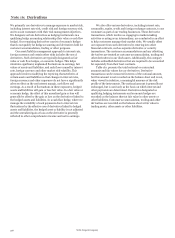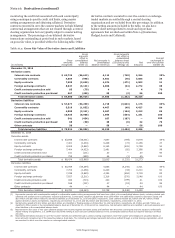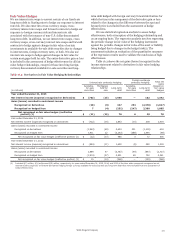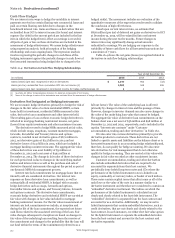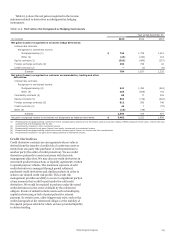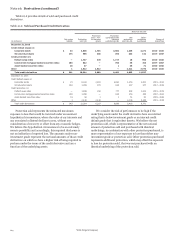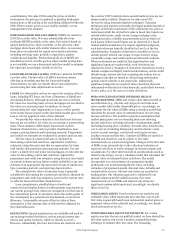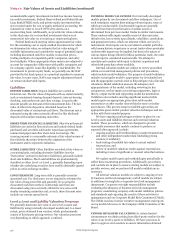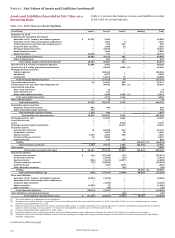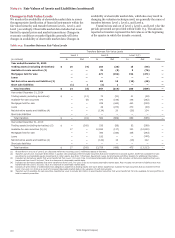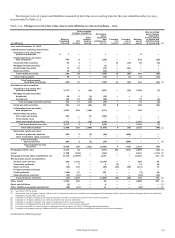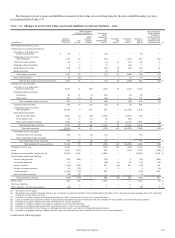Wells Fargo 2015 Annual Report Download - page 219
Download and view the complete annual report
Please find page 219 of the 2015 Wells Fargo annual report below. You can navigate through the pages in the report by either clicking on the pages listed below, or by using the keyword search tool below to find specific information within the annual report.securitizations. We value CDOs using the prices of similar
instruments, the pricing of completed or pending third-party
transactions or the pricing of the underlying collateral within the
CDO. Where vendor prices are not readily available, we use
management's best estimate.
MORTGAGES HELD FOR SALE (MHFS) MHFS are carried at
LOCOM or at fair value. We carry substantially all of our
residential MHFS portfolio at fair value. Fair value is based on
quoted market prices, where available, or the prices for other
mortgage whole loans with similar characteristics. As necessary,
these prices are adjusted for typical securitization activities,
including servicing value, portfolio composition, market
conditions and liquidity. Predominantly all of our MHFS are
classified as Level 2. For the portion where market pricing data
is not available, we use a discounted cash flow model to estimate
fair value and, accordingly, classify as Level 3.
LOANS HELD FOR SALE (LHFS) LHFS are carried at LOCOM
or at fair value. The fair value of LHFS is based on current
offerings in secondary markets for loans with similar
characteristics. As such, we classify those loans subjected to
nonrecurring fair value adjustments as Level 2.
LOANS For information on how we report the carrying value of
loans, including PCI loans, see Note 1 (Summary of Significant
Accounting Policies). Although most loans are not recorded at
fair value on a recurring basis, reverse mortgages are recorded at
fair value on a recurring basis. In addition, we record
nonrecurring fair value adjustments to loans to reflect partial
write-downs that are based on the observable market price of the
loan or current appraised value of the collateral.
We provide fair value estimates in this disclosure for loans
that are not recorded at fair value on a recurring or nonrecurring
basis. Those estimates differentiate loans based on their
financial characteristics, such as product classification, loan
category, pricing features and remaining maturity. Prepayment
and credit loss estimates are evaluated by product and loan rate.
The fair value of commercial loans is calculated by
discounting contractual cash flows, adjusted for credit loss
estimates, using discount rates that are appropriate for loans
with similar characteristics and remaining maturity. For real
estate 1-4 family first and junior lien mortgages, we calculate fair
value by discounting contractual cash flows, adjusted for
prepayment and credit loss estimates, using discount rates based
on current industry pricing (where readily available) or our own
estimate of an appropriate discount rate for loans of similar size,
type, remaining maturity and repricing characteristics.
The estimated fair value of consumer loans is generally
calculated by discounting the contractual cash flows, adjusted for
prepayment and credit loss estimates, based on the current rates
we offer for loans with similar characteristics.
Loan commitments, standby letters of credit and
commercial and similar letters of credit generate ongoing fees at
our current pricing levels, which are recognized over the term of
the commitment period. In situations where the credit quality of
the counterparty to a commitment has declined, we record an
allowance. A reasonable estimate of the fair value of these
instruments is the carrying value of deferred fees adjusted for
the related allowance.
DERIVATIVES Quoted market prices are available and used for
our exchange-traded derivatives, such as certain interest rate
futures and option contracts, which we classify as Level 1.
However, substantially all of our derivatives are traded in over-
the-counter (OTC) markets where quoted market prices are not
always readily available. Therefore we value most OTC
derivatives using internal valuation techniques. Valuation
techniques and inputs to internally-developed models depend on
the type of derivative and nature of the underlying rate, price or
index upon which the derivative's value is based. Key inputs can
include yield curves, credit curves, foreign exchange rates,
prepayment rates, volatility measurements and correlation of
such inputs. Where model inputs can be observed in a liquid
market and the model does not require significant judgment,
such derivatives are typically classified as Level 2 of the fair
value hierarchy. Examples of derivatives classified as Level 2
include generic interest rate swaps, foreign currency swaps,
commodity swaps, and certain option and forward contracts.
When instruments are traded in less liquid markets and
significant inputs are unobservable, such derivatives are
classified as Level 3. Examples of derivatives classified as Level 3
include complex and highly structured derivatives, certain credit
default swaps, interest rate lock commitments written for our
mortgage loans that we intend to sell and long-dated equity
options where volatility is not observable. Additionally,
significant judgments are required when classifying financial
instruments within the fair value hierarchy, particularly between
Level 2 and 3, as is the case for certain derivatives.
MSRs AND CERTAIN OTHER INTERESTS HELD IN
SECURITIZATIONS MSRs and certain other interests held in
securitizations (e.g., interest-only strips) do not trade in an
active market with readily observable prices. Accordingly, we
determine the fair value of MSRs using a valuation model that
calculates the present value of estimated future net servicing
income cash flows. The model incorporates assumptions that
market participants use in estimating future net servicing
income cash flows, including estimates of prepayment speeds
(including housing price volatility), discount rates, default rates,
cost to service (including delinquency and foreclosure costs),
escrow account earnings, contractual servicing fee income,
ancillary income and late fees. Commercial MSRs are carried at
LOCOM and, therefore, can be subject to fair value
measurements on a nonrecurring basis. Changes in the fair value
of MSRs occur primarily due to the collection/realization of
expected cash flows as well as changes in valuation inputs and
assumptions. For other interests held in securitizations (such as
interest-only strips), we use a valuation model that calculates the
present value of estimated future cash flows. The model
incorporates our own estimates of assumptions market
participants use in determining the fair value, including
estimates of prepayment speeds, discount rates, defaults and
contractual fee income. Interest-only strips are recorded as
trading assets. Our valuation approach is validated by our
internal valuation model validation group. Fair value
measurements of our MSRs and interest-only strips use
significant unobservable inputs and, accordingly, we classify
them as Level 3.
FORECLOSED ASSETS Foreclosed assets are carried at net
realizable value, which represents fair value less costs to sell.
Fair value is generally based upon independent market prices or
appraised values of the collateral and, accordingly, we classify
foreclosed assets as Level 2.
NONMARKETABLE EQUITY INVESTMENTS For certain
equity securities that are not publicly traded, we have elected the
fair value option, and we use a market comparable pricing
technique to estimate their fair value. The remaining
Wells Fargo & Company
217



